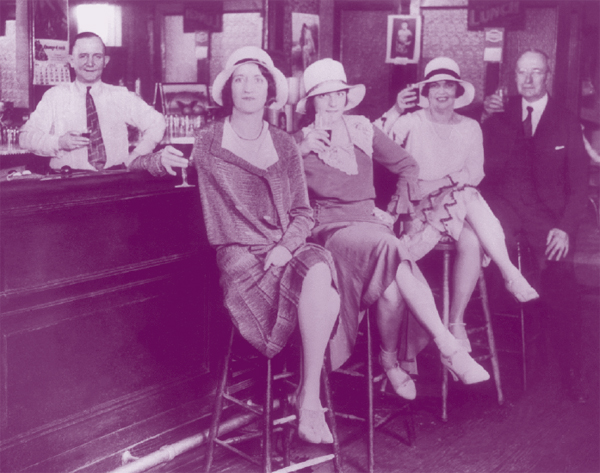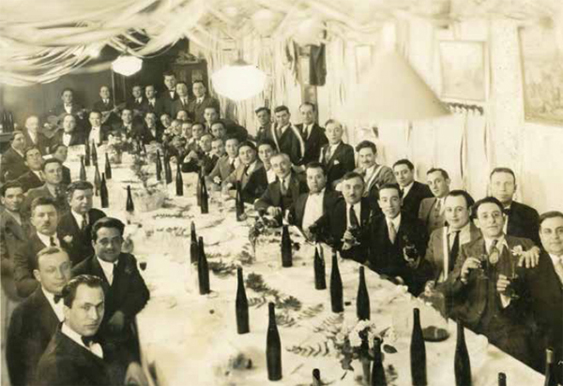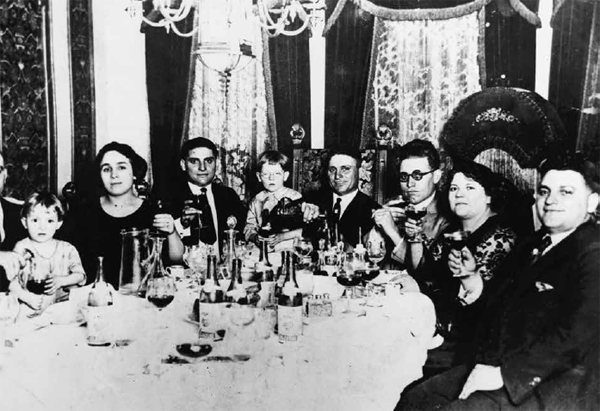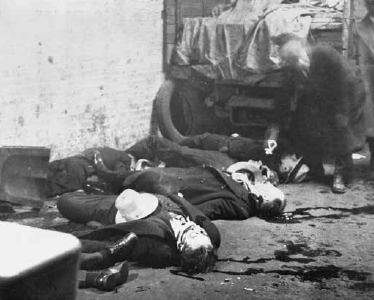Protestant lawmakers, detesting what they saw as the menace of alcohol, enacted legislation to restrict it. Any drink with a standard alcoholic content could no longer be legally sold.
Protestant lawmakers, detesting what they saw as the menace of alcohol, enacted legislation to restrict it. Any drink with a standard alcoholic content could no longer be legally sold.
Panicked by the addition of millions of immigrants, the incipient rise of organized labor to counter the brutalities of industrialization, and the emergence of radical politics, white Protestant lawmakers resorted to a more zealous moralism. Detesting what they saw as the menace of alcohol and its effects on the ethnic working class, they became determined to enact the “noble experiment” of restricting it. But the reformers could never have imagined that their impulse to control human behavior by forbidding a five-cent saloon beer at the end of a long day would lead to the creation of a sophisticated organized crime network that operated successfully for the rest of the twentieth century.
On January 16, 1920, the Volstead Act, named for Minnesota congressman Andrew J. Volstead, became law, forbidding “the manufacture, sale, or transportation of intoxicating liquors.” From the start, the law was almost completely unenforceable, with roughly thirty-three hundred agents to patrol a population of nearly 106 million people. Many of these agents were political appointees, the products of patronage machines, which meant they could be easily bribed. Prohibition did stop working-class people from socializing in neighborhood saloons. But it also whet the appetite of the middle and upper classes, especially young and newly emancipated women, ready to flaunt convention and rebel against an oppressive moralism, as they stepped into unlicensed bars known as speakeasies.
Before Prohibition, a clear demarcation existed between a dangerous criminal element and the majority of the hardworking citizenry, with the two rarely, if ever interacting. Prohibition erased this line, allowing gangsters the ability to socialize with the affluent in speakeasies and nightclubs. In cities like New York, indulging in Prohibition nightlife and its aura of gentle illegality not only was titillating but defined cosmopolitanism. Keeping the social set wet by stocking speakeasies, cabarets, and nightclubs with liquor, as well as becoming the private bootlegger for parties held by the elite, helped legitimize gangsters, earned them hundreds of millions of dollars, and provided them with the accoutrements of a successful life: cars, women, and fancy homes.

For middle-class and wealthy women, drinking at a speakeasy defined cosmopolitanism.
Italian-American criminals in the earlier part of the century, like the Black Hand gangs, had made their money through prostitution, gambling, and extortion schemes. In states that had been dry before Prohibition, Italian Americans controlled a bootlegging business; in the formerly dry state of Colorado, for example, that business centered in Denver. But Italian Americans did not dominate the national crime scene until Prohibition, which turned previous hoodlums, muggers, and robbers into gangsters—cunning, brutal, and enormously successful.

Members of the Italian-American Monte Vulture Social Club celebrate with wine in the dry year of 1929. As an old proverb had it: “Six months a year Italians drink wine; the other six months, they don’t drink any water.”
As soon as the law went into place, criminal activity soared, starting with the robbing of warehouses stocked full with spirits that could no longer be legally sold. After that supply ran dry, some bootleggers worked with brewery owners willing to skirt the law. Breweries continued the usual distilling process of producing spirits with a standard alcohol content of 3–4 percent, and then “de-alcoholized” the product to 0.5 percent, the legal limit under Prohibition. This process enabled the owners, or the gangsters who now fronted for them, to siphon off the harder stuff from the original production.

The Genna brothers, members of a Chicago gangster family, raise a glass together.
Much of the alcohol consumed during Prohibition was smuggled from Canada and overseas via trucks, trains, boats, and airplanes. Bootleggers also used homemade stills, and criminals like former Black Hand member Frank Yale (Americanized from “Uale”) paid residents of the Bay Ridge section of Brooklyn to produce spirits with one-gallon home stills—and shot those who seemed inclined to squeal about the practice. In Chicago, the Genna brothers paid neighbors fifteen dollars a day to produce moonshine in every home so that the brothers could sell the home stills’ production of roughly 350 gallons of raw alcohol a week.
The original bootleggers were Irish and Jews, with Italians following behind. Italian-American criminals ran bootlegging businesses in Los Angeles, Kansas City’s Little Italy, Boston’s North End, Detroit, Chicago, and New York. These children of immigrants thought school a burden, not a means to success, and most dropped out when they were fourteen or even younger, finding a shortcut to the American dream of wealth and power.
Because the money to be made was enormous, so was the amount of blood shed. Former Black Hand members, now newly minted bootleggers, understood how to employ brutal and unpredictable violence to eliminate rival gangs and consolidate their power. One of the most famously violent of this new crop of gangsters was Chicago’s Al Capone. He assumed control of his syndicate from a mastermind named John Torrio, who had both politicians and police on his payroll and managed competing criminal interests like a savvy CEO. Torrio advocated cooperation among gangsters instead of competition, and the arrangement lasted until a mayor was elected who wouldn’t succumb to the syndicate’s tactics. When Torrio was finally arrested, the tenuous gangster peace ended, eventually replaced by a bloody free-for-all.
The loud and crude Capone, who was born in Brooklyn and had dropped out of school after the sixth grade, pushed violence and mayhem to a new degree. Torrio had started by taking over the production of once-legal breweries; under his guidance, Capone helped expand their enterprise to gambling and prostitution. Capone, lacking the patience and calm of Torrio, did not take lightly to violations of peace arrangements made by warring gangsters divvying up these businesses. When George (“Bugs”) Moran refused to honor one such arrangement, Capone responded by sending four men (two were dressed as police officers) into a garage to murder seven members of Moran’s group.

Capone arranged the shocking killings known as the St. Valentine’s Day Massacre.
With over a thousand bullets fired, the shockingly gruesome murders, known as the St. Valentine’s Day Massacre, appalled the public. This reaction eventually pushed the federal government to act, arresting Capone for tax evasion two years later, in 1931. Capone, spending most of the decade in prison and suffering from the effects of syphilis, never recovered, but the power of his organized crime syndicate carried on.
Besides Capone, no Italian-American gangster matched the power and viciousness of New York’s criminals competing for the most lucrative illegal liquor market in the country. New York—“Satan’s seat,” in the words of a Protestant minister and temperance leader—was home to over thirty-two thousand speakeasies and nightclubs. The fight for dominance resulted in the murder of over a thousand gangsters in the 1920s. The ugliness of these murders—machine gun firing squads, burlap bags dropped into cement and sea, bodies burned in automobiles—was also unparalleled.
The most influential mobster of the 1950s, Frank Costello—who owned a lavish Central Park West apartment and appeared on the cover of Time and Newsweek—made his way up the ranks through bootlegging. Born Francesco Castiglia in Calabria, he had come to America as a young boy with his parents, who settled in East Harlem. From the age of seventeen he had been arrested several times for robberies, but the early cases against him had been dismissed. At twenty-four, he was arrested again and spent nearly a year in jail. After his release, Costello married a Jewish woman and worked easily with Irish and Jewish gangsters, enabling him to branch out from the world of solely Italian-American thugs.
By the 1920s, Costello and future mob head Charlie (“Lucky”) Luciano, the man later credited for creating the organizational structure of the modern American Mafia, were both members of a powerful bootlegging gang. Costello worked as a rumrunner, meeting boats off the coast of Long Island, transferring the liquor to his trucks, and making sure troublesome competition stepped out of the way. Both men came under the influence of Jewish gangster Arnold Rothstein (known as “The Brain”), who tutored them in how to make large sums of money in illegal alcohol and expand to other businesses.
Costello bore a tremendous grudge over the ways in which poor Italians accepted their sorry lot in America. Unlike radical leftists, such as the Galleanisti, who believed that American capitalists deserved letter bombs for their abuse of workers, Costello’s attack on “the system” came through a criminal version of capitalist entrepreneurship. Like the twenty-first-century fictional mobster Tony Soprano, who confessed to his shrink about his demanding mother, Costello complained to his Park Avenue psychiatrist that he hated the humility and meekness of his father, who had settled for poverty and poor treatment. He also deplored his inability to be accepted as a legitimate businessman, despite investing over the decades in legal pursuits.
Along with fellow New York bootleggers Lucky Luciano and Joe Bonanno, Costello ran speakeasies and nightclubs, mingled with rich New Yorkers, and aspired to at least the appearance of legitimacy—a far cry from street thug, gang, or Black Hand members. By the time Prohibition ended in 1933, these local mob leaders had made partnerships with bootleggers across the country. Seeking new streams of revenue, the gangsters expanded into business and labor racketeering. Unions like the International Longshoremen’s Association and the Teamsters were particularly vulnerable. The gangsters demanded kickbacks for finding jobs and secured payments from businesses that depended on truck deliveries. Rich and unaffected by the Depression, they also returned to their earlier sources of income—gambling, loan-sharking, prostitution, and the expanding market for narcotics.
Over the next few decades these Italian Americans, along with Jewish gangsters like Meyer Lansky and Ben (“Bugsy”) Siegel, dominated the criminal landscape, leaving the ethnic ghettos they had come from to establish multimillion-dollar illegal empires. Prohibition taught them that crime did pay—if you were shrewd and ruthless enough to get out alive.
If only the sincere but inept Protestant reformers, trying to shape how immigrants became American, could have stuck to suggesting oatmeal and left their efforts at the breakfast table. By successfully stopping the legal production of alcohol for thirteen years, they spawned a savvy organized crime network that grew rapidly and exponentially in sophistication and reach.
In East Harlem in the first decades of the twentieth century, there couldn’t have been a greater moral and intellectual divide between tenement coevals, the revered educator Leonard Covello and the wily mobster Frank Costello. Sadly, popular culture, with its attraction to Italian-American criminals, made Costello, not Covello, the more famous of the two. Another man, however—a short, stocky, and pugnacious politician representing East Harlem as a congressman—would also capture the country’s imagination and soon come to symbolize the early extraordinary achievements of Italians in America.